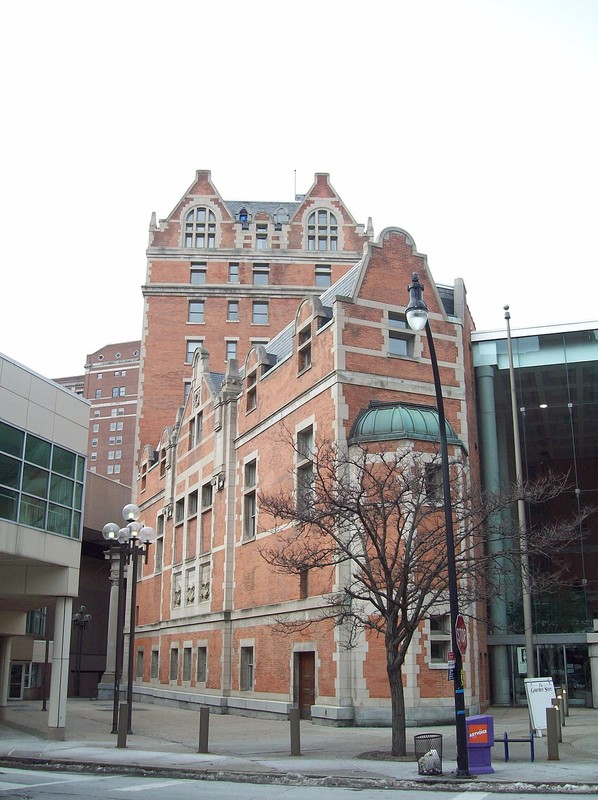YMCA Central Building
Introduction
Text-to-speech Audio
Although sandwiched between the Buffalo Niagara Convention Center and an annex built in 1986, the former YMCA Central Building remains an important architectural and social landmark in Buffalo. It was the location of the third oldest YMCA chapter in North America and the second oldest chapter in the United States. Founded in 1852, the chapter operated until the early 1980s. Erected in 1902, the building is also notable for its English-Flemish Revival architecture. It was built of brick and features a large, ten-story central tower section with dormers and a two-story portico of Tuscan columns. Decorative features include sandstone string courses and quoins. The building was one of the city's tallest when it was built. It was added to the National Register of Historic Places in 1983.
Images
Built in 1902, YMCA Central Building was home to the third oldest YMCA chapter in North America and the second oldest in the United States. YMCA operations ended in the early 1980s and the building was converted into offices.

Backstory and Context
Text-to-speech Audio
The YMCA (Young Men's Christian Association) was established in London in 1844. The first chapter in North America opened in Montreal in 1851 and then the second (and first in the U.S.) opened in 1852 in Boston. In the coming years, chapters continued to be established in other major cities around the country in Canada. The Buffalo chapter played a prominent role in the organization. In 1854, the North American chapters in Buffalo here to form an organization called the International Committee, which was responsible for overseeing the growth of the YMCA worldwide.
The Buffalo chapter met in several buildings until it built a facility in 1883. Designed in the Victorian Gothic style, it featured a library, classrooms, and gyms. It was eventually torn down. By 1900, the chapter membership grew to become the fourth largest in the country. The 1883 building was inadequate and it was clear that a new facility was needed for the chapter's many recreational, religious, and social activities. As a result, the chapter went ahead with plans to build the present structure. It was perhaps the first YMCA chapter building to contain dorm rooms for members and was the first to contain a spa. Subsequent chapter buildings contained these accommodations as well.
As noted above, the YMCA chapter operated until the early 1980s. The facility was converted into an office building and the annex and the glass atrium connecting the two buildings were constructed in 1986. In early 2012, the building (including the annex) was sold to investors for $2.5 million.
Sources
Epstein, Jonathan D. "Olympic Towers sold for $2.5 million; Sale ends hard chapter in landmark's history; investors plan upgrades, new amenities." The Buffalo News. https://buffalonews.com/news/olympic-towers-sold-for-2-5-million-sale-ends-hard-chapter-in-landmarks-history-investors/article_f27dfcff-dac4-5669-8296-a159f8b.
Kowsky, Frank. "YMCA Central Building." National Park Service - National Register of Historic Places Nomination Form. September 8, 1983. https://s3.amazonaws.com/NARAprodstorage/lz/electronic-records/rg-079/NPS_NY/83001676.pdf.
Wikimedia Commons: https://commons.wikimedia.org/wiki/File:Young_Men%27s_Christian_Association_Central_Building.JPG
